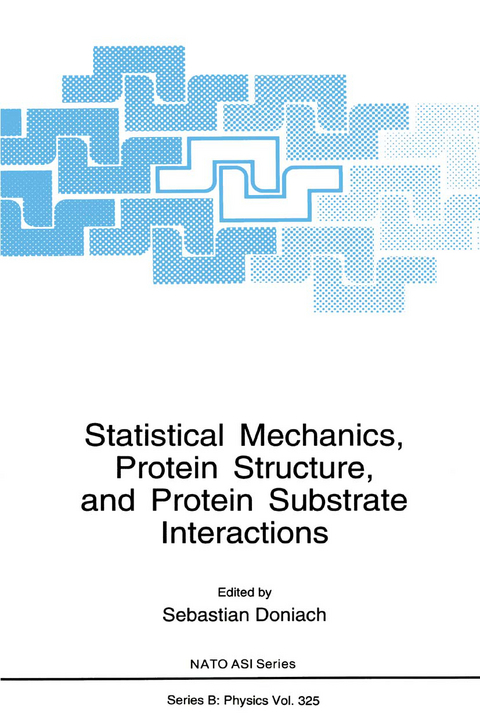
Statistical Mechanics, Protein Structure, and Protein Substrate Interactions
Kluwer Academic/Plenum Publishers (Verlag)
978-0-306-44728-0 (ISBN)
Protein Folding Intermediates.- Pathways and Mechanism of Protein Folding.- The Folding Pathway of Apomyoglobin.- Circular Dichroism Stopped-Flow Studies of Folding Intermediates.- Native-like Intermediates in Protein Folding.- A First-Order Phase Transition Between a Compact Denatured State and a Random Coil State in Staphylococcal Nuclease.- Studies in Protein Stability.- Studies on “Hyperstable” Proteins: Crystallins from the Eye-Lens and Enzymes from Thermophilic Bacteria.- Origins of Mutation Induced Stability Changes in Barnase: An Analysis Based on Free Energy Calculations.- Basic Interactions.- Monte Carlo Simulation of Electrostatic Interactions in Biomolecules.- The Molecular Origin of the Large Entropies of Hydrophobic Hydration.- Statistical Mechanical Models and Protein States.- Statistical Mechanics of Secondary Structures in Proteins: Characterization of a Molten Globule-like State.- Hydrophobic Zippers: A Conformational Search Strategy for Proteins.- Theoretical Perspectives on In Vitro and In Vivo Protein Folding.- On the Configurations Accessible to Folded and to Denatured Proteins.- Exploring Conformation Space.- Experiences with Dihedral Angle Space Monte Carlo Search for Small Protein Structures.- Constrained Langevin Dynamics of Polypeptide Chains.- MOIL: A Molecular Dynamics Program with Emphasis on Conformational Searches and Reaction Path Calculations.- Flexibility in the Fc Region of Immunoglobulin G.- NMR Data and Protein Structure.- Computer-Supported Protein Structure Determination by NMR.- Enumeration with Constraints: A Possible Approach to Protein Structure Reconstruction from NMR Data.- A Decomposition of the nOe Intensity Matrix.- Membrane Proteins.- Structure and Dynamics of Membrane Proteins.- Steps Toward Predicting the Structureof Membrane Proteins.- The Protein Data Base: Fold Families and Structure Prediction.- Protein Fold Families and Structural Motifs.- Data Based Modeling of Proteins.- Applications of Knowledge Based Mean Fields in the Determination of Protein Structures.- A New Approach to Protein Folding Calculations.- Knowledge Based Potentials for Predicting the Three-Dimensional Conformation of Proteins.- Protein-Substrate Interactions.- Protein-Protein Recognition: An Analysis by Docking Simulation.- Molecular Dynamics Simulation of an Antigen-Antibody Complex: Hydration Structure and Dissociation Dynamics.- Multiple Conformations of Cystatin, Mung Bean Inhibitor and Serpins.- Structure and tRNA Phe-Binding Properties of the Zinc Finger Motifs of HIV-1 Nucleocapsid Protein.- Electrostatic Complementarity in Protein-Substrate Interactions and Ligand Design.- Molecular Engineering in the Preparation of Bioactive Peptides.- Author Index.
| Erscheint lt. Verlag | 30.9.1994 |
|---|---|
| Reihe/Serie | NATO Science Series: B ; 325 |
| Zusatzinfo | IX, 406 p. |
| Verlagsort | New York |
| Sprache | englisch |
| Maße | 178 x 254 mm |
| Themenwelt | Naturwissenschaften ► Biologie ► Zoologie |
| Naturwissenschaften ► Physik / Astronomie ► Angewandte Physik | |
| ISBN-10 | 0-306-44728-2 / 0306447282 |
| ISBN-13 | 978-0-306-44728-0 / 9780306447280 |
| Zustand | Neuware |
| Haben Sie eine Frage zum Produkt? |
aus dem Bereich


